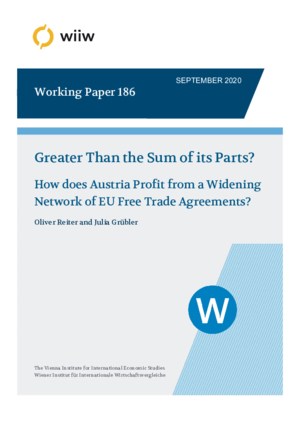Greater than the Sum of its Parts? How does Austria Profit from a Widening Network of EU Free Trade Agreements?
Julia Grübler and Oliver Reiter
wiiw Working Paper No. 186, September 2020
40 pages including 10 Tables and 13 Figures
Political debates and economic analyses often focus on single free trade agreements and their potential economic effects on participating trading partners. This study contributes to the literature by shedding light on the significance of trade agreements in the context of countries’ positions in worldwide trade agreement networks, by combining network theory with gravity trade modelling. We illustrate, both numerically and graphically, the evolution of the global web of trade agreements in general, and the network of the European Union specifically, accounting for the geographical and temporal change in the depth of agreements implemented. Gravity estimations for the period 1995-2017 distinguish the direct bilateral effects of trade agreements from indirect effects attributable to the scope of trade networks and countries’ positions therein.
Keywords: Free trade agreements, network effects, trade policy, structural gravity model
JEL classification: D58, F13, F14, F43
Countries covered: Austria, European Union, Germany, Japan, Global, MERCOSUR
Research Areas: International Trade, Competitiveness and FDI
